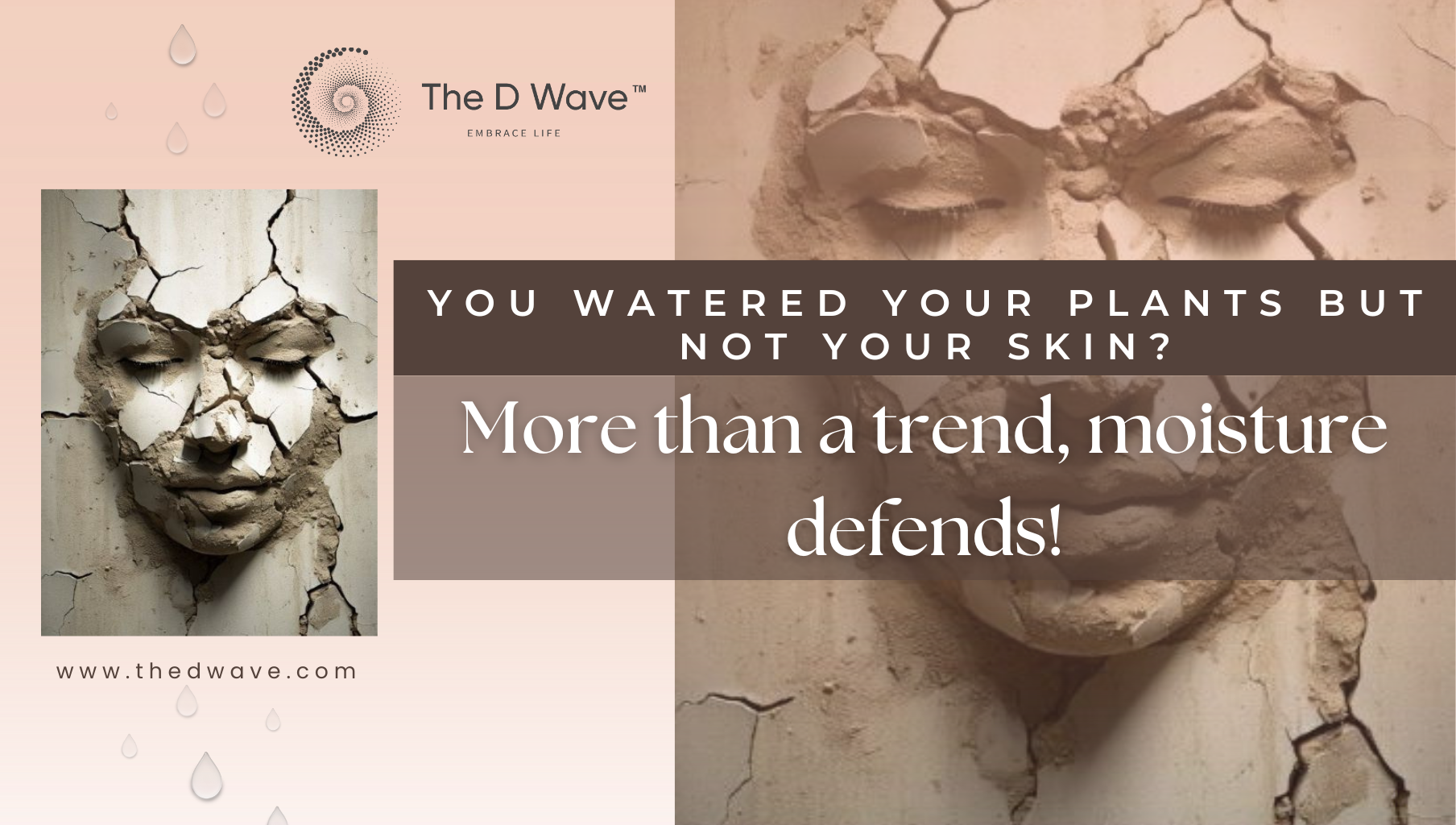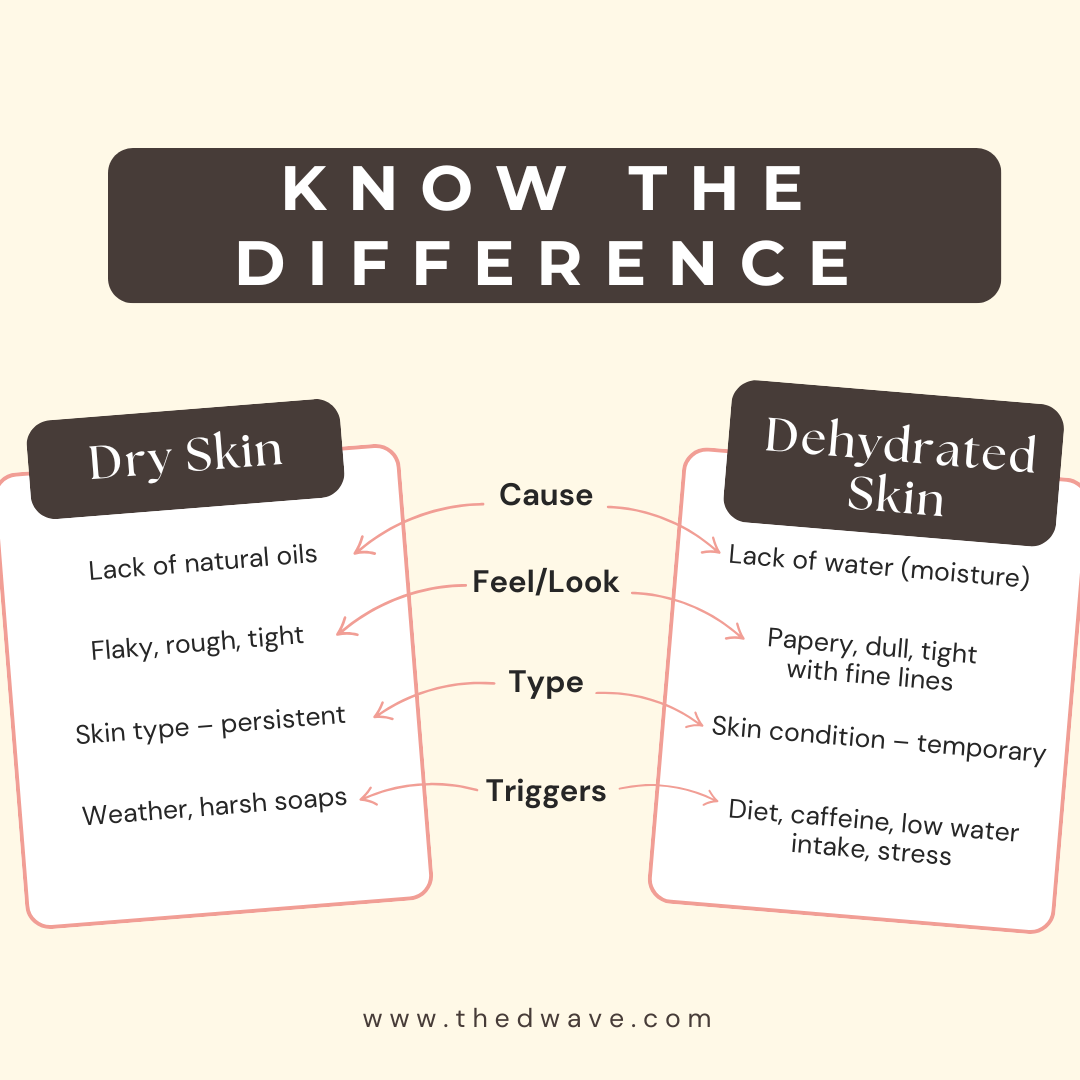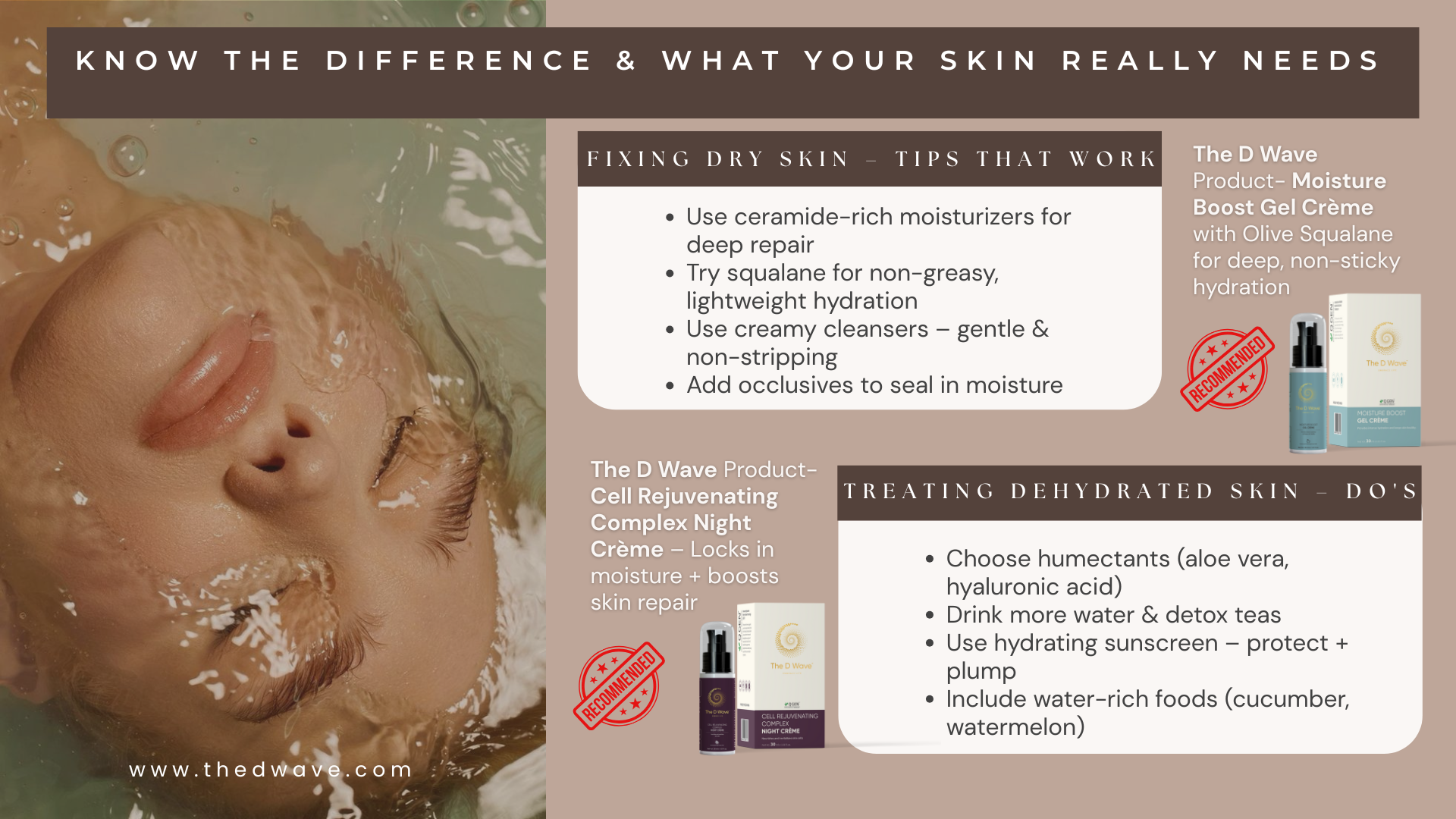Skin care always starts identifying your type spot on. Once identified, it’s about understanding
that, while some skin types might be in the same vicinity, requirements will always be unique.
And that is the case of dry vs dehydrated skin. While both are characterised by a sense
of
dryness, the way it reflects on each of these skin types is different. Let us first take you
through dehydrated and dry skin to further break it down.
Dry Skin features
-
Lack of natural skin oil
-
Dry and flaky skin on the face
-
This is typically a skin type
-
The dryness in this case is permanent and needs to be regularly addressed
-
Cold weather, harsh soaps can trigger it further
Dehydrated skin features
-
Lack of water content (moisture)
-
Papery texture that feels tight
-
The fine lines are more pronounced because of the dehydration
-
It may appear dull, shallow under the eye
-
This condition is usually temporary and is treatable
-
Low water intake, hormonal changes, high caffeine intake, poor nutrition are triggers
How can we fix dry skin?
The primary goal is to replenish skin proteins to rebuild on the skin’s protective shield.
-
Rich moisturisers that contain ceramides, squalane, help rebuild your skin’s structural
integrity.
-
Ceramides make up for a large portion of the stratum corneum and that’s why
refuelling your skin with a ceramide-rich moisturiser helps repair the barrier
and create an armour against external aggressors. Ceramides most importantly
help lock in the moisture so that it penetrates into the skin.
-
Squalane imitates the function of skin oils to deeply hydrate the skin without
leaving it feeling clogged. Its non-comedogenic properties ensure light-weight
hydration.
-
Creamy cleansers are preferred for dry skin because they
-
Will cleanse the skin without stripping the skin of its natural oils
-
Creamy cleansers are gentler on the skin and won’t trigger irritation. Further
they usually contain soothing ingredients that calm the skin.
-
Considering their creamy texture, they provide moisture even while cleansing.
-
Integrate occlusive ingredients into your skin care routine for sealed hydration.
-
Occlusion refers to the technique of creating a protective layer to ensure the
moisture is locked in for deeper hydration.
-
Further it can help increase the absorption efficacy of other products.
How to treat dehydrated skin
The ultimate goal is to improve on your skin’s water content thus enhancing its capacity to
retain moisture.
-
Use humectants like aloe vera, hyaluronic acid to protect your skin from trans-epidermal
water loss.
-
When it comes to dehydrated skin, the prime requirement is hydration followed by
moisturisation, that’s why humectants are best suited.
-
They draw in water from the environment, they are light-weight making it
suitable for even oily skin. They also help with elasticity. Oily skin can also
be dehydrated.
-
Sunscreen - dehydrated skin is more prone to sun damage.
-
Ensure your sunscreen along with creating an armour hydrates your skin leaving
it feeling plump, dewy and protected.
-
Improve on hydration from within
-
Improve your water intake, opt for detox teas, and include water-based foods in
your diet.
-
The increased water content will lend your skin a glow and work towards
addressing dehydration naturally.
Two products from our D-Wave range that we would recommend for Dry and Dehydrated skin:
Cell Rejuvenating Complex Night Cream is
just what your dehydrated skin needs. It helps renew
tired skin, strengthens the skin’s barrier and creates a protective layer against external
aggressors. Further, it helps with Trans epidermal water loss locking in all the moisture; over
all a complete solution for moisture lacking skin.
But when it comes to dry skin, you have to opt for Moist Boost Gel Creme. It contains Olive
squalane, a light-weight moisturising ingredient that provides deep seated hydration without
your skin feeling sticky and heavy. Its non-comedogenic properties also ensure your pores don't
feel congested. You are just left with moisturised, supple skin.
Ultimately, it's important to understand the finer differences in your skin so that you provide
the most suited solution for desired results. A customisable solution is the best skincare
routine you can give your skin!
FAQ
1.How do you fix dry skin fast?
A Moisturising mask that is designed for activating your skin’s natural oils is the best
immediate fix.
Another way to fix dry skin is to incorporate slugging into your routine - This includes
moisturising followed by an occlusive cream - While the moisturiser will nourish your skin, the
occlusive cream will lock it all in; You wake up to plumped, dewy skin!
2.How to fix dry skin from dehydration?
While dehydration can affect dry and oily skin, one way to prevent dry skin from dehydration is
to add formulations that stimulate hydration. This could be followed by an occlusive cream that
could seal in the moisture and work on improving naturally dry skin. Thus, the combination of
hydration and moisturisation is best for dry skin to prevent it from dehydration.
3.How can I tell if my skin is dry or dehydrated?
When it comes to dry vs dehydrated skin,
-
Differentiation can be made basis texture:
Dry skin tends to be rough, flaky, cracked
while dehydrated skin tends to look dull, tight, water-starved.
-
Type vs temporary condition:
Dry skin is a skin type where the skin feels dry and
flaky on the face; the characteristics are usually permanent and require irregular care.
Dehydrated skin tends to look tight and dull, but it is usually temporary and can be
treatable. Dehydration usually occurs due to hormonal changes, low water intake or other
external stressors like air conditioner, UV exposure. Also, lines are more apparent on
dehydrated skin.
Interestingly, oily skin can also be dehydrated. That's why it can look oilier in
certain areas to over-compensate for the lack of moisture.
4.What is the best way to treat dehydrated skin?
The best way is to include a holistic solution that works on improving the water content from the
inside and outside.
It’s not enough to resort to humectants, light-weight moisturiser to help with water loss, it’s
as integral to work on water intake, include detox drinks and indulge in water-based fruits and
veggies - Cucumber, Watermelon, Tomato, Muskmelon.


















